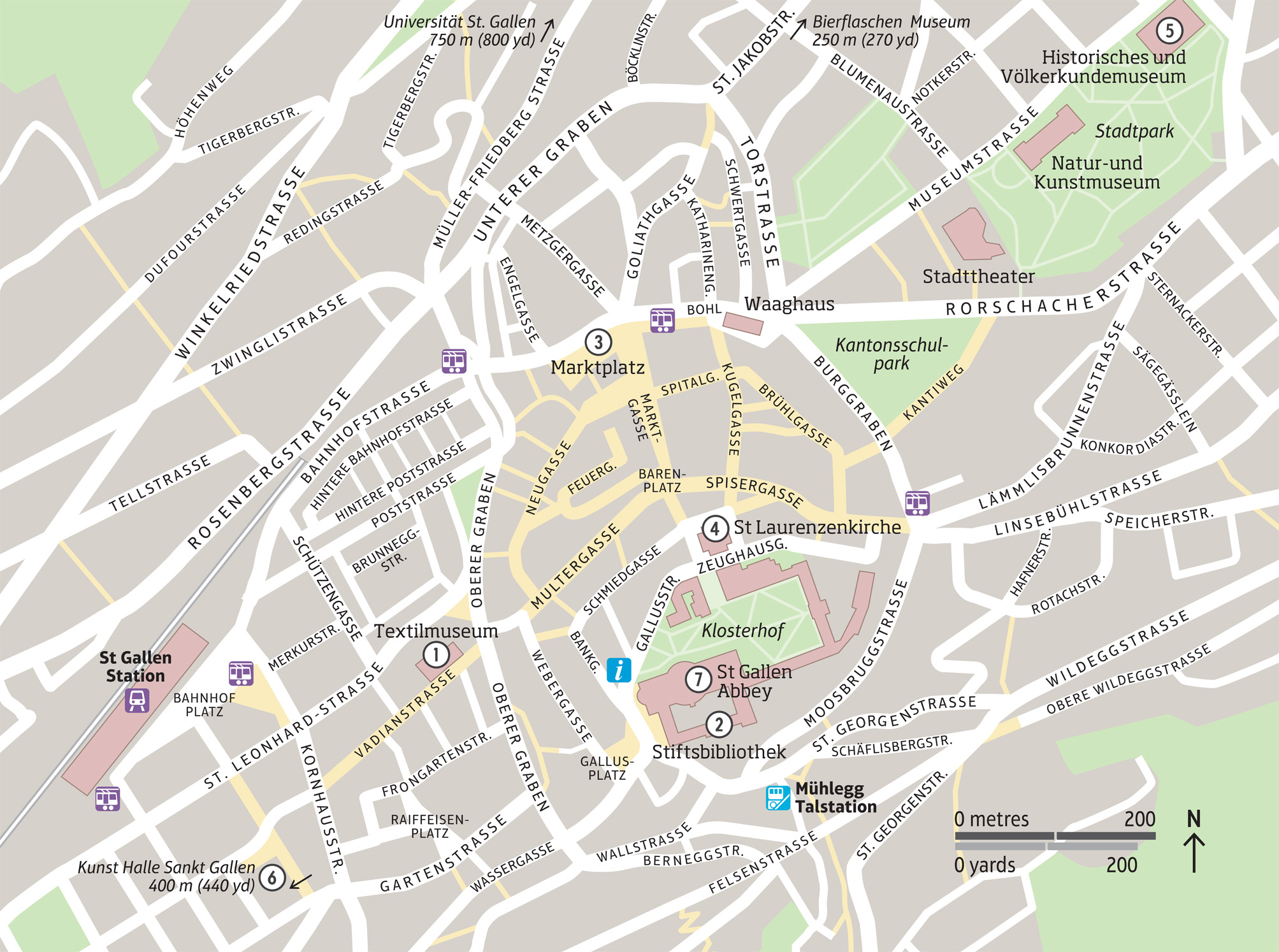The origins of St Gallen, eastern Switzerland’s largest town, go back to 612, when Gallus, an Irish monk, chose the spot for his hermitage. A Benedictine abbey was founded here in 747 and soon became a centre of learning and culture; today, the abbey is a UNESCO World Heritage Site. By the 19th century, St Gallen was renowned for its textile industry. While the city’s focal point is its magnificent cathedral, built in 1847, it also has a beautiful medieval centre.

t The beautiful Rococco reading hall of St Gallen Abbey’s Stiftsbibliothek
Experience Eastern Switzerland and Graubünden

n Double-tap image to read the labels
Reflecting St Gallen’s role as a centre of the European textiles industry, this museum is filled with a comprehensive array of pieces from Switzerland and abroad, including antique fabrics from Coptic graves in Egypt. The well-presented displays examine social questions through design and fashion, connecting Swiss history with the art of weaving, as well as intricate embroidery and exquisite handmade lace. Local patterns and products, and the implements that were devised to produce them, are also shown.
Although most of the abbey was destroyed during the Reformation, its important library, the Stiftsbibliothek, was spared. The main room, designed by Peter Thumb in 1758–67, is a stunning Baroque masterpiece, with elaborate Rococo touches. The wooden floor was intricately inlaid by Gabriel Loser, and the ceiling is decorated with stuccowork by Johann Georg and Mathias Gigl and trompe l’oeil paintings by Josef Wannenmacher.
The library contains more than 170,000 books and documents, including an important collection of Irish manuscripts dating from the 8th to the 11th centuries, and rare works dating from the 8th century. Books printed after 1900 may be borrowed, but anything older can only be read onsite in the reading rooms

Hidden Gem
Bierflaschen Museum
A must-visit for any beer lover, Switzerland’s first beer bottle museum (www.schuetzengarten.ch) features more than 2,000 bottles from over 260 Swiss breweries – all empty. The well-curated exhibits are arranged by region forming an impressive display of Swiss beer history.
Once the town’s main market square, Marktplatz lies on the northern side of the old town. The square is surrounded by fine 17th- and 18th-century houses with intricately painted façades or decorated with delicate relief carving. Many also have attractive oriel windows, a feature typical of St Gallen’s architecture.
On Marktgasse, the street leading off the southern side of Marktplatz, Labhart is a long-standing watchmaker’s shop with a fascinating collection of musical boxes.
Did You Know?
St Gallen’s university was decorated by some of the most innovative artists of the 20th century.
This church was originally part of the abbey complex. During the 16th century it became a centre of the Reformation in St Gallen. The building’s present Neo-Gothic façade is the result of remodelling carried out in the mid-19th century.
The museum of history and ethnology focuses on the people and past of the town and region of St Gallen. As well as archaeological pieces, there are documents, mementos and reconstructions of domestic life from various periods, going back as far as prehistory. Highlights include a scale reconstruction of St Gallen’s abbey and a model of the city as it was in the 17th century. The ethnographic collection also has Asian, African and South American artifacts.
This contemporary art hall sees itself as “a large small exhibitor”, and an experimental space for artists to express themselves freely. The exhibits change regularly, keeping pace with developments in the world of contemporary art.
